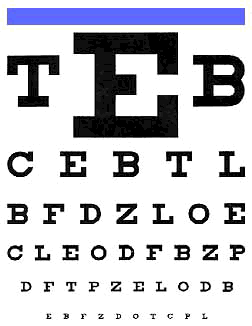|
|
|

The blue "standardization bar" must be measured in centimetres on your
computer screen or printout. You should then stand in a position back from
your computer screen so that your eye is this same number of feet from
the screen. i.e. if the blue bar measures 9 1/2 centimetres in length,
you should stand back so that your eye is 9 1/2 feet from the screen.
Vision testing should be performed on each eye separately, wearing
distance eyeglasses if required. There are six lines on the screen, you
should note the last line number in which you can read most (50-75%) of
the letters.
The middle letter of the top line is equivalent to 20/200 (or 6/60). A person unable to read this letter with best eyeglass correction is considered legally blind.
The "T" and the "B" on the top line are equivalent to 20/100 (or about 6/36). The second line is 20/50 (about 6/18). Best corrected acuity in the range between 20/50 and 20/100 is considered disabling in occupations which require work with numbers or extensive reading.
The third line is equivalent to 20/40 (6/12), it is the "driver's test" line. You must be able to read most of the letters on this line in order to obtain an unrestricted drivers license in most states.
The bottom three lines represent 20/30 (6/9), 20/20 (6/6) and 20/10 (> 6/5). These are considered to be "normal vision" with the 20/20 line being the traditional normal vision line. 20/20 vision is equivalent to 6/6 which is another convention of denoting visual acuity. It is generally felt that the maximum visual acuity of the eye is around 20/15 or 20/16. This means that if you are able to read the bottom line, you are probably a good guesser.
This vision test can only be considered a screening test. A variety of factors such as lighting, glare, monitor quality may have an effect on the results of this test. For final assessment consult your eye specialist.